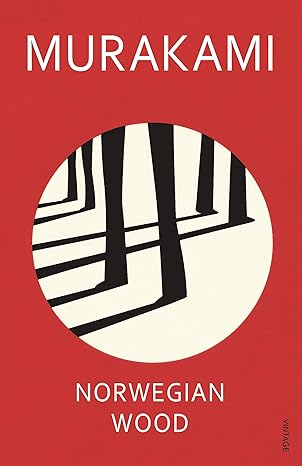Norwegian Wood

Norwegian Wood
- ASIN : 0099448823
- Publisher : RHUK; Latest edition (17 May 2001)
- Language : English
- Paperback : 400 pages
- ISBN-10 : 9780099448822
- ISBN-13 : 978-0099448822
- Item Weight : 1 kg 50 g
- Dimensions : 12.9 x 2.4 x 19.5 cm
- Country of Origin : United Kingdom
- Net Quantity : 1.00 count
Product description
Review
In 1987, when Norwegian Wood was first published in Japan, it promptly sold more than 4 million copies and transformed Haruki Murakami into a pop-culture icon. The horrified author fled his native land for Europe and the United States, returning only in 1995, by which time the celebrity spotlight had found some fresher targets. And now he’s finally authorized a translation for the English-speaking audience, turning to the estimable Jay Rubin, who did a fine job with his big-canvas production The Wind-Up Bird Chronicle. Readers of Murakami’s later work will discover an affecting if atypical novel, and while the author himself has denied the book’s autobiographical import–“If I had simply written the literal truth of my own life, the novel would have been no more than fifteen pages long”–it’s hard not to read as at least a partial portrait of the artist as a young man.
Norwegian Wood is a simple coming-of-age tale, primarily set in 1969-70, when the author was attending university. The political upheavals and student strikes of the period form the novel’s backdrop. But the focus here is the young Watanabe’s love affairs, and the pain and pleasure and attendant losses of growing up. The collapse of a romance (and this is one among many!) leaves him in a metaphysical shambles:I read Naoko’s letter again and again, and each time I read it I would be filled with the same unbearable sadness I used to feel whenever Naoko stared into my eyes. I had no way to deal with it, no place I could take it to or hide it away. Like the wind passing over my body, it had neither shape nor weight, nor could I wrap myself in it.This account of a young man’s sentimental education sometimes reads like a cross between Sylvia Plath’s The Bell Jar and Stephen Vizinczey’s In Praise of Older Women. It is less complex and perhaps ultimately less satisfying than Murakami’s other, more allegorical work. Still, Norwegian Wood captures the huge expectation of youth–and of this particular time in history–for the future and for the place of love in it. It is also a work saturated with sadness, an emotion that can sometimes cripple a novel but which here merely underscores its youthful poignancy. –Mark Thwaite
Catches the absorption and giddy rush of adolescent love… It is also, for all the tragic momentum and the apparently kamikaze consciousness of many of its characters, often funny and quirkily observed. Quietly compulsive and finally moving ― Times Literary Supplement
Norwegian Wood is Japan’s The Catcher in the Rye ― Daily Telegraph
Everyone who reads Norwegian Wood runs out to buy copies for friends and lovers… Drawing on Fitzgerald, Capote, Chandler and the Japanese tradition, his books are at once disarmingly direct and slyly, charmingly evasive. They are playful and melancholy; full of wrong turns and red herrings, corridors that lead nowhere and – above all – girls who disappear ― Guardian
A masterly novel. . . . Norwegian Wood bears the unmistakable marks of Murakami’s hand ― The New York Times Book Review
This book is undeniably hip, full of student uprisings, free love, booze and 1960s pop, it’s also genuinely emotionally engaging, and describes the highs of adolescence as well as the lows ― Independent on Sunday
From the Inside Flap
First American Publication
This stunning and elegiac novel by the author of the internationally acclaimed Wind-Up Bird Chronicle has sold over 4 million copies in Japan and is now available to American audiences for the first time. It is sure to be a literary event.
Toru, a quiet and preternaturally serious young college student in Tokyo, is devoted to Naoko, a beautiful and introspective young woman, but their mutual passion is marked by the tragic death of their best friend years before. Toru begins to adapt to campus life and the loneliness and isolation he faces there, but Naoko finds the pressures and responsibilities of life unbearable. As she retreats further into her own world, Toru finds himself reaching out to others and drawn to a fiercely independent and sexually liberated young woman.
A poignant story of one college student’s romantic coming-of-age, Norwegian Wood takes us to that distant place of a young man’s first, hopeless, and heroic love.
From the Back Cover
First American Publication
This stunning and elegiac novel by the author of the internationally acclaimed Wind-Up Bird Chronicle has sold over 4 million copies in Japan and is now available to American audiences for the first time. It is sure to be a literary event.
Toru, a quiet and preternaturally serious young college student in Tokyo, is devoted to Naoko, a beautiful and introspective young woman, but their mutual passion is marked by the tragic death of their best friend years before. Toru begins to adapt to campus life and the loneliness and isolation he faces there, but Naoko finds the pressures and responsibilities of life unbearable. As she retreats further into her own world, Toru finds himself reaching out to others and drawn to a fiercely independent and sexually liberated young woman.
A poignant story of one college student’s romantic coming-of-age, Norwegian Wood takes us to that distant place of a young man’s first, hopeless, and heroic love.
About the Author
In 1978, Haruki Murakami was twenty-nine and running a jazz bar in downtown Tokyo. One April day, the impulse to write a novel came to him suddenly while watching a baseball game. That first novel, Hear the Wind Sing, won a new writers’ award and was published the following year. More followed, including A Wild Sheep Chase and Hard-Boiled Wonderland and the End of the World, but it was Norwegian Wood, published in 1987, that turned Murakami from a writer into a phenomenon.
In works such as The Wind-Up Bird Chronicle, 1Q84, What I Talk About When I Talk About Running and Men Without Women, Murakami’s distinctive blend of the mysterious and the everyday, of melancholy and humour, continues to enchant readers, ensuring his place as one of the world’s most acclaimed and well-loved writers.

